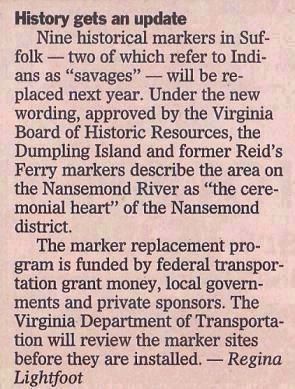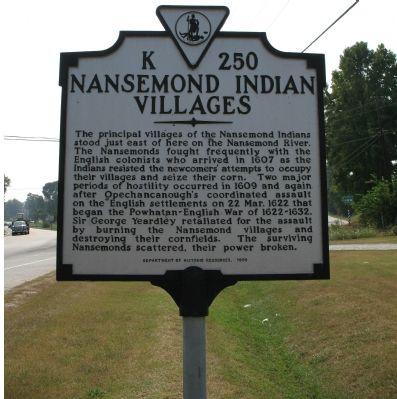Chuckatuck in Suffolk, Virginia — The American South (Mid-Atlantic)
Nansemond Indian Villages
Erected 1998 by Department of Historic Resources. (Marker Number K-250.)
Topics and series. This historical marker is listed in these topic lists: Colonial Era • Native Americans • Settlements & Settlers • Wars, US Indian. In addition, it is included in the Virginia Department of Historic Resources (DHR) series list. A significant historical date for this entry is March 22, 1622.
Location. 36° 51.121′ N, 76° 35.363′ W. Marker is in Suffolk, Virginia. It is in Chuckatuck. Marker is at the intersection of Godwin Boulevard (Virginia Route 10) and Everets Road (County Route 603), on the right when traveling south on Godwin Boulevard. Touch for map. Marker is at or near this postal address: 5641 Godwin Blvd, Suffolk VA 23432, United States of America. Touch for directions.
Other nearby markers. At least 8 other markers are within 6 miles of this marker, measured as the crow flies. St. John's Church (approx. 1.6 miles away); Dumpling Island (approx. 2.3 miles away); James Bowser Plantation (approx. 4.4 miles away); African American Oystermen (approx. 5.1 miles away); Sleepy Hole Ferry (approx. 5.3 miles away); Yeates School (approx. 5.3 miles away); James Bowser, Revolutionary Soldier (approx. 5.3 miles away); Revolutionary Camp (approx. 5.3 miles away). Touch for a list and map of all markers in Suffolk.
Related markers. Click here for a list of markers that are related to this marker. Nansemond Indians
Additional commentary.
1. K-250 marker history
Most readers of Virginia’s roadside historical markers do not know that Nansemond Indian Villages was not the initial title assigned to the designation symbol “K-250.” The original title assigned in 1927 by the Virginia Conservation and Development Commission was Reid’s Ferry (see Related markers). The commission, a predecessors of the Department of Historic Resources (DHR), developed those unique “letter-and-number” symbols to be used with titles in

Courtesy of The Sun.
2. History gets an update
Nine historical markers in Suffolk—two of which refer to Indians as “savages”—will be replaced next year. Under the new wording, approved by the Virginia Board of Historic Resources, the Dumpling Island and former Reid’s Ferry markers describe the area on the Nansemond River as “the ceremonial heart” of the Nansemond district. The marker replacement program is funded by federal transportation grant money, local governments and private sponsors. The Virginia Department of Transportation will review the marker sites before they are installed. —Regina Lightfoot” Dec 27, 1998 in The Sun, a part of The Virginian-Pilot newspaper.
— Submitted December 21, 2020.
Credits. This page was last revised on February 1, 2023. It was originally submitted on September 23, 2007, by Laura Troy of Burke, Virginia. This page has been viewed 3,101 times since then and 69 times this year. Last updated on December 20, 2020, by Cynthia L. Clark of Suffolk, Virginia. Photos: 1. submitted on September 23, 2007, by Laura Troy of Burke, Virginia. 2. submitted on December 20, 2020, by Cynthia L. Clark of Suffolk, Virginia. • Bernard Fisher was the editor who published this page.
Editor’s want-list for this marker. Wide shot of marker and its surroundings. • Can you help?
